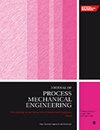热输入对双脉冲 MIG 焊接 IN 617 的机械和冶金方面的影响
IF 2.2
4区 工程技术
Q2 ENGINEERING, MECHANICAL
Proceedings of the Institution of Mechanical Engineers, Part E: Journal of Process Mechanical Engineering
Pub Date : 2024-07-25
DOI:10.1177/09544089241263448
引用次数: 0
摘要
本文试图分析输入热量对铬镍铁合金 617(IN 617)双脉冲金属惰性气体(DP MIG)焊接的影响。用直径为 1.2 mm 的 IN 617 焊丝以对接方式焊接 IN 617 板材。在 31.3、37.1 和 41.5 J/mm 的不同热输入条件下进行了三次焊接试验。焊接质量通过焊缝几何形状、拉伸强度、韧性和硬度进行评估。使用光学显微镜、扫描电子显微镜、能量色散光谱仪和背散射能量衍射仪讨论了机械性能的变化。在输入热量发生微小变化的情况下,焊缝拉伸强度发生了显著变化。在所有焊接样品中都观察到了钼偏析现象。在较低的热输入下,拉伸测试结果比母材降低了 31.62%。同样,在中高热量输入时,拉伸强度分别降低了 25.13% 和 49.59%。与母材相比,焊缝的韧性较低,而且没有观察到韧性随热量输入变化而有明显变化。在所有三种热输入条件下,焊缝的硬度几乎与母材相似。部分熔化区出现液化裂纹。在较高的热输入下,观察到侧壁熔化不足,同时出现液化裂纹。本文章由计算机程序翻译,如有差异,请以英文原文为准。
Effect of heat input on the mechanical and metallurgical aspects of double-pulse MIG welded IN 617
In this article, an attempt is made to analyze the influence of heat input in double-pulse metal inert gas (DP MIG) welding of Inconel 617 (IN 617). IN 617 plates were joined in the butt joint configuration with 1.2 mm diameter IN 617 filler wire. Three welding trials were conducted at different heat input, viz. 31.3, 37.1, and 41.5 J/mm. Weld quality was assessed using bead geometry, tensile strength, toughness, and hardness. The changes in mechanical properties were discussed using the optical microscope, scanning electron microscope with energy dispersion spectroscopy, and backscattered energy diffraction. Substantial changes were observed in the weld tensile strength for a small variation in heat input. Molybdenum segregation was observed in all the weld samples. At lower heat input, the tensile test was reduced by 31.62% compared with base metal. Similarly, for the medium and high heat input, the tensile strength was reduced by 25.13% and 49.59%, respectively. Weld had lower toughness compared with the base metal and no significant variation was observed in toughness to changes in heat input. Hardness of the weld at all three heat inputs was almost similar to base metal. Liquation cracks were seen in the partially melted zone. At higher heat input, the lack of sidewall fusion was observed along with liquation crack.
求助全文
通过发布文献求助,成功后即可免费获取论文全文。
去求助
来源期刊
CiteScore
3.80
自引率
16.70%
发文量
370
审稿时长
6 months
期刊介绍:
The Journal of Process Mechanical Engineering publishes high-quality, peer-reviewed papers covering a broad area of mechanical engineering activities associated with the design and operation of process equipment.

 求助内容:
求助内容: 应助结果提醒方式:
应助结果提醒方式:


